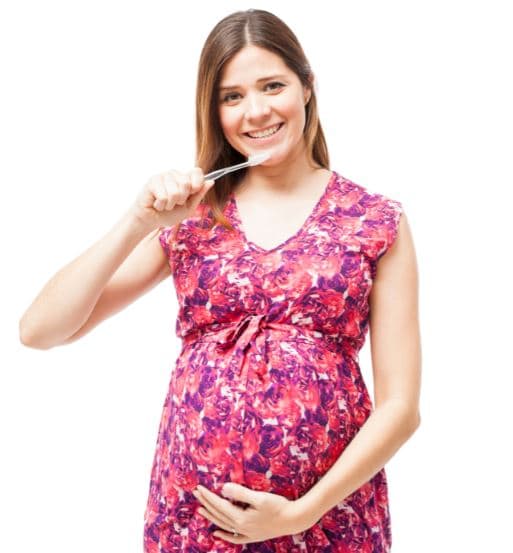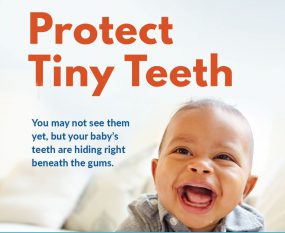Pregnancy and Oral Health
Healthcare professionals: use Protect Tiny Teeth, a free set of resources, to talk to pregnant women and new moms about the importance of oral health.
One way to prevent cavities in young children is to improve pregnant women’s oral health. Pregnancy may make women more prone to periodontal (gum) disease and cavities. Oral health may be considered an important part of prenatal care, given that poor oral health during pregnancy can lead to poor health outcomes for the mother and baby. Protect Tiny Teethexternal icon includes a mix of attention-grabbing materials to spark awareness that oral health should be part of prenatal care, and tips on how pregnant women and new moms can protect their oral health and the oral health of their infants.
Pregnancy and Periodontal Disease
Nearly 60 to 75% of pregnant women have gingivitis, an early stage of periodontal disease that occurs when the gums become red and swollen from inflammation that may be aggravated by changing hormones during pregnancy.1 If gingivitis is not treated, the bone that supports the teeth can be lost, and the gums can become infected. Teeth with little bone support can become loose and may eventually have to be extracted. Periodontitis has also been associated with poor pregnancy outcomes, including preterm birth and low birth weight.2 However, how periodontitis may lead to adverse pregnancy outcomes is not yet fully understood.

Dental care is safe and important during pregnancy.
Pregnancy and Dental Cavities
Pregnant women may also be at risk for cavities due to changes in behaviors, such as eating habits.3 Women who have a lot of cavity-causing bacteria during pregnancy and after delivery could transmit these bacteria from their mouth to the mouth of their baby.4 Early contact with these bacteria and to other sugars, such as from frequent snacking or taking a bottle to bed, can lead to early childhood cavities and the need for extensive dental care at a young age.
- 1 in 4 women of childbearing age have untreated cavities.5
- Children of mothers who have high levels of untreated cavities or tooth loss are more than 3 times more likely to have cavities as a child.6
- Children with poor oral health status are nearly 3 times more likely to miss school because of dental pain.7
How Protect Tiny Teeth Can Help
All health care providers, including primary care, pediatric and maternity care providers, may consider paying more careful attention to oral health. Through a cooperative agreement with the Centers for Disease Control and Prevention, the American Academy of Pediatrics worked to create Protect Tiny Teethexternal icon, an oral health communications resource designed to make conversations easier between pregnant women, moms and her healthcare providers.
Protect Tiny Teeth includes a mix of attention-grabbing materials to spark awareness that oral health should be part of prenatal care and tips on how to protect the oral health of their infants. Resources for medical providers and community liaisons with infographics and brief videos with tips for how to reach the intended audience are also included. The materials are designed to support assessing women’s and young children’s needs, and provide talking points for a conversation about oral health and resources to leave with the woman.
The Protect Tiny Teeth toolkit is available for free access on AAP.orgexternal icon with materials in English and Spanish with some materials available in multiple languages. A web site for the public is also available at Healthychildren.org/tinyteethexternal icon.
- CDC Division of Oral Health, Oral Health Basics
- American Academy of Pediatrics, Protect Tiny Teeth Toolkit for Pregnant and New Momsexternal icon
- American Academy of Pediatrics, Protect Tiny Teeth Toolkit for Providers external icon
- American Dental Association Council on Access, Prevention, and Interprofessional Relations, 2006.
- Corbella S, Taschieri S, Del Fabbro M, Francetti L, Weinstein R, Ferrazzi E. Adverse pregnancy outcomes and periodontitis: A systematic review and meta-analysis exploring potential association. Quintessence Int. 2016 Mar;47(3):193-204. doi: 10.3290/j.qi.a34980.
- Romero BC, Chiquito CS, Elejalde LE, Bernadoni CB. Relationship between periodontal disease in pregnant women and the nutritional condition of their newborns. J Periodontol 2002;73:1177-1183.
- Azofeifa A, Yeung LF, Alverson CJ, Beltrán‐Aguilar E. Dental caries and periodontal disease among U.S. pregnant women and nonpregnant women of reproductive age, National Health and Nutrition Examination Survey, 1999–2004. Journal of Public Health Dentistry, 2016;76: 320-329. doi:10.1111/jphd.12159.
- Lindquist B, Emilson CG. Colonization of Streptococcus mutans and Streptococcus sobrinus genotypes and caries development in children to mothers harboring both species. Caries Res. 2004;38(2):95-103.
- Dye BA, Vargas CM, Lee JJ, Magder L, Tinanoff N. Assessing the Relationship Between Children’s Oral Health Status and That of Their Mothers. J Am Dent Assoc. 2011;142(2), 173-183. doi:10.14219/jada.archive.2011.0061.
- Jackson SL, Vann WF, Kotch JB, Pahel BT, Lee JY. Impact of poor oral health on children’s school attendance and performance. Am J Public Health 2011;101:1900–6.
